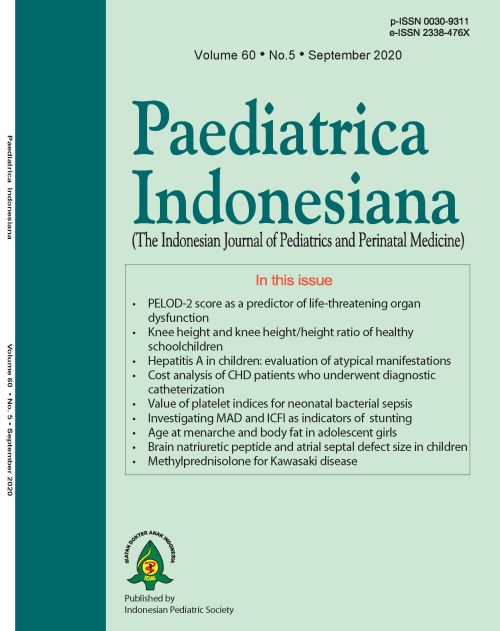Validation of PELOD-2 score as a predictor of life-threatening organ dysfunction in pediatric sepsis
Abstract
Background The Third International Consensus Definitions for Sepsis and Septic Shock (Sepsis-3) defined sepsis as life-threatening organ dysfunction due to immune dysregulation against infection. It recommends the Sequential (sepsis-related) Organ Failure Assessment (SOFA) score to evaluate life-threatening organ dysfunction. But the SOFA tool has not been adjusted for pediatric patients. The Indonesian Pediatrics Society (IPS) uses the same sepsis definition and recommends using the PELOD-2 score as an indicator of life-threatening organ dysfunction in children.
Objective To evaluate the validity of the PELOD-2 score for predicting life-threatening organ dysfunction in pediatric sepsis.
Methods A prospective cohort study was conducted in children with sepsis who were admitted to the PICU. Subjects were taken consecutively with inclusion criteria of 1 month-18 years of age, with organ dysfunction, having two or more symptoms of systemic inflammatory response syndrome (SIRS), and suspected or proven infection. PELOD-2 score, with and without lactate result, of each subject were plotted to receiver operating characteristic (ROC) curve, then we determined the most optimal cut off point to predict the life-threathneing organ dysfunction in pediatric sepsis based on the sensitivity and specificity of each score.
Results Sixty-six patients were analyzed, with 40 males and 26 females aged 2 to 183 months (median 11 months). Twenty patients died while in the PICU. A PELOD-2 score (with lactate) cut-off ≥ 7 was determined by ROC curve, with sensitivity of 80% and specificity of 78%. The area under the curve (AUC) of PELOD-2 score (with lactate) was 84.8% (95%CI 74.7 to 95.9%). A PELOD-2 score (without lactate) ≥ 7 was the most optimum cut off based on its Youden index, it haD 70% of sensitivity and 80% of specificity.
Conclusion PELOD-2 score ≥ 7 , with or without lactate component is the optimal cut-off for predicting life-threatening organ dysfunction in pediatric sepsis.
References
2. Bone RC, Balk RA, Cerra FB, Dellinger RP, Fein AM, Knaus WA, et al. Definitions for sepsis and organ failure and guidelines for the use of innovative therapies in sepsis. Chest. 1992;101:1644–55. DOI:10.1378/chest.101.6.1644
3. Levy MM, Fink MP, Marshall JC, Abraham E, Angus D, Cook D, et al. 2001 SCCM/ESICM/ACCP/ATS/SIS International Sepsis Definitions Conference. Intensive Care Med. 2003;29:530-8. DOI 10.1007/s00134-003-1662-x
4. Goldstein B, Giroir B, Randolph A. International pediatric sepsis consensus conference: definitions for sepsis and organ dysfunction in pediatrics. Pediatr Crit Care Med. 2005;6:2–8. DOI: 10.1097/01.PCC.0000149131.72248.E6
5. Matics TJ, Sanchez-Pinto N.Adaptation and validation of a Pediatric Sequential Organ Failure Assestment Score and evaluation of The Sepsis-3 definitions in critically ill children . JAMA Pediatr. 2017; 2352:E1-9. doi:10.1001/jamapediatrics.2017.2352.
6. Hadinegoro SRS, Chairulfatah A, Latief A, Pudjiadi AH, Malisie RF, Alam A. Konsensus: diagnosis dan tata laksana sepsis pada anak. Jakarta: Badan Penerbit Ikatan Dokter Anak Indonesia; 2016. p.1-5
7. Suari NMR. Validasi skor PELOD-2 pada anak dengan sepsis [thesis]. [Jakarta: Universitas Indonesia; 2017.
8. Leclerc F, Duhamel A, Deken V, Grandbastien B, Leteurtre S, Group Francophone de Reanimation et Urgences Pediatriques (GFRUP). Can the Pediatric Logistic Organ Dysfunction-2 Score on day 1 be used in clinical criteria for sepsis in children? Pediatr Crit Care Med. 2017;18:758–63. DOI: 10.1097/PCC.0000000000001182.
9. Prescott CH. The epidemiology of sepsis. In: Wiersinga WJ, Seympur CW, editors. Handbook of sepsis. 1st ed. : Cham: Springer International Publishing; 2018. p. 17-26. DOI 10.1007/978-3-319-73506-1
10. Bindl L, Buderus S, Dahlem P, Demirakea S, Goldner M, Huth R, et al. Gender-based differences in children with sepsis and ARDS: the ESPNIC ARDS database group. Intensive Care Med. 2003;29:1770–3. DOI 10.1007/s00134-003-1948-z.
11. Vallet B. Bench-to-bedside review: endothelial cell dysfunction in severe sepsis: a role in organ dysfunction? Crit Care. 2003;7:130-8. DOI: 10.1186/cc1864
12. Akobeng AK. Understanding diagnostic tests 3: receiver operating characteristic curves. Acta Paediatrica. 2007;96:644-7. DOI:10.1111/j.1651-2227.2006.00178.x
Copyright (c) 2020 Yulia Iriani, Yuyun Romaria Simanjuntak, Indra Saputra, Silvia Triratna, Achirul Bakri

This work is licensed under a Creative Commons Attribution-NonCommercial-ShareAlike 4.0 International License.
Authors who publish with this journal agree to the following terms:
Authors retain copyright and grant the journal right of first publication with the work simultaneously licensed under a Creative Commons Attribution License that allows others to share the work with an acknowledgement of the work's authorship and initial publication in this journal.
Authors are able to enter into separate, additional contractual arrangements for the non-exclusive distribution of the journal's published version of the work (e.g., post it to an institutional repository or publish it in a book), with an acknowledgement of its initial publication in this journal.
Accepted 2020-07-07
Published 2020-07-07













